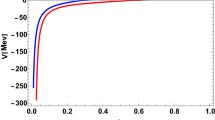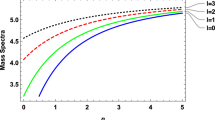Abstract
We derive an assumption-free mass relation that connects heavy-quark mesons (\(c\bar{c}\), \(b\bar{b}\) and \(B_c\) mesons) with different quantum numbers, but same orbital angular momentum. The obtained formula is exact, provided the hyperfine mass splitting, \(\delta _{hf}\), and \(\delta _\xi :=M(n^1 L_\ell )/M(n^3 L_\ell )-1\) are determined independently. For completeness, we obtain the heavy-quark mesons spectrum following a Schrödinger wave equation (SWE) approach. The Song-Lin potential is employed along with the corresponding relativistic corrections, namely: spin-spin, spin-orbit and tensor interactions. Our numerical strategy is based upon the Numerov method, which enables us to cast our SWE approach into a matrix eigenvalue problem, for which high numerical accuracy can be achieved. Notably, only a single set of parameters is required to produce the known spectrum of the heavy-quark mesons.
Similar content being viewed by others
References
Murray Gell-Mann. The Eightfold Way: A Theory of strong interaction symmetry. 3 1961
Susumu Okubo, Note on unitary symmetry in strong interactions. Prog. Theor. Phys. 27, 949–966 (1962)
Craig D. Roberts, Empirical consequences of emergent mass. Symmetry 12(9), 1468 (2020)
A. Bazavov et al., Equation of state in (2+1)-flavor QCD. Phys. Rev. D 90, 064503 (2014)
Miguel Angel Escobedo, Effective field theory and lattice QCD approaches for hard probes in QCD matter. PoS, HardProbes 2018, 026 (2018)
Rasmus Larsen, Stefan Meinel, Swagato Mukherjee, Peter Petreczky, Bethe-Salpeter amplitudes of Upsilons. Phys. Rev. D 102, 114508 (2020)
N. Brambilla et al., Heavy quarkonium: progress, puzzles, and opportunities. Eur. Phys. J. C 71, 1534 (2011)
Khepani Raya, Minghui Ding, Adnan Bashir, Lei Chang, Craig D. Roberts, Partonic structure of neutral pseudoscalars via two photon transition form factors. Phys. Rev. D 95(7), 074014 (2017)
Minghui Ding, Fei Gao, Lei Chang, Y.-X. Liu, Roberts, Leading-twist parton distribution amplitudes of S-wave heavy-quarkonia. Phys. Lett. B 753, 330–335 (2016)
Taichi Kawanai, Shoichi Sasaki, Potential description of charmonium and charmed-strange mesons from lattice QCD. Phys. Rev. D 92(9), 094503 (2015)
E. Eichten, K. Gottfried, T. Kinoshita, John B. Kogut, K.D. Lane, and Tung-Mow Yan. The Spectrum of Charmonium. Phys. Rev. Lett., 34: 369–372, 1975. [Erratum: Phys.Rev.Lett. 36, 1276 (1976)]
E. Eichten, K. Gottfried, T. Kinoshita, K.D. Lane, and Tung-Mow Yan. Charmonium: The Model. Phys. Rev. D, 17:3090, 1978. [Erratum: Phys.Rev.D 21, 313 (1980)]
E. Eichten, K. Gottfried, T. Kinoshita, K.D. Lane, Tung-Mow. Yan, Charmonium: comparison with experiment. Phys. Rev. D 21, 203 (1980)
Adedayo O. Adelakun, Abajingin D. Dele, Solution of quantum anharmonic oscillator with quartic perturbation. Adv. Phys. Theories Appl. 27(10), 38–43 (2014)
Jamil Ahmed, Rahila Manzoor, Alfredo Raya, Variational constraints of masses and radii of \(c\bar{c}\)-mesons. Quantum Phys. Lett. 6(08), 99–103 (2017)
Jami Ahmed, Rahila Manzoor, Alfredo Raya, A new variational technique and its applications to heavy quarkonia. Revista Mexicana de Física 67(1), 33–53 (2021)
Xiao-tong Song, H.-F. Lin, A new potential model for heavy quarkonium. Z. Phys. C 34, 223 (1987)
Mohamed Chabab, Latifa Sanhaji, Confining interquark potentials from nonAbelian gauge theories coupled to dilaton. Int. J. Mod. Phys. A 20, 1863–1866 (2005)
E. Leader and E. Predazzi (1982) An introduction to gauge theories and the ‘New Physics’. 1
Myron Bander, Theories of quark confinement. Phys. Rept. 75, 205 (1981)
William H. Press, Saul A. Teukolsky, William T. Vetterling, Brian P. Flannery, Numerical Recipes 3rd Edition: The Art of Scientific Computing, 3rd edn. (Cambridge University Press, USA, 2007)
Halil Mutuk, Spin averaged mass spectrum of heavy quarkonium via asymptotic iteration method. Can. J. Phys. 97(12), 1342–1348 (2019)
Mohandas Pillai, Josh Goglio, Thad Walker, Matrix numerov method for solving schrödingers equation. Am. J. Phys. 80(11), 1017–1019 (2012)
Yasser Mustafa, Galal Hassan, and Tarek Nahool (2014) Numerical study of heavy mesons spectra using matrix numerovs method. Int. J. New. Hor. Phys, 01
S. Titard, F.J. Yndurain, Rigorous QCD evaluation of spectrum and other properties of heavy q anti-q systems. Phys. Rev. D 51, 6348–6363 (1995)
Richard F. Lebed, Eric S. Swanson, Quarkonium \(h\) states as arbiters of exoticity. Phys. Rev. D 96(5), 056015 (2017)
Clara Peset, Antonio Pineda, Jorge Segovia, P-wave heavy quarkonium spectrum with next-to-next-to-next-to-leading logarithmic accuracy. Phys. Rev. D 98(9), 094003 (2018)
Lei Chang, Muyang Chen, Xue-qian Li, Y.-X. Liu, K. Raya, Can the hyperfine mass splitting formula in heavy Quarkonia be applied to the \(B_c\) system? Few Body Syst. 62(1), 4 (2021)
S. Dobbs et al., Precision measurement of the mass of the h(c)(P-1(1)) state of charmonium. Phys. Rev. Lett. 101, 182003 (2008)
I. Adachi et al., First observation of the \(P\)-wave spin-singlet bottomonium states \(h_b(1P)\) and \(h_b(2P)\). Phys. Rev. Lett. 108, 032001 (2012)
P.A. Zyla et al., Review of particle physics. PTEP 2020(8), 083C01 (2020)
Henry Lamm, \(P-\)state positronium for precision physics: an ultrafine splitting at \(\alpha ^6\). Phys. Rev. A 96(2), 022515 (2017)
J. Segovia, C. Albertus, D.R. Entem, F. Fernandez, E. Hernandez, M.A. Perez-Garcia, Semileptonic \(B\) and \(B_{s}\) decays into orbitally excited charmed mesons. Phys. Rev. D 84, 094029 (2011)
X.-H. Guo, K.-W. Wei, X.-H. Wu, Some mass relations for mesons and baryons in Regge phenomenology. Phys. Rev. D 78, 056005 (2008)
Wolfgang Lucha and Franz F. Schoberl. Effective potential models for hadrons. In International Summer School for Students on Development in Nuclear Theory and Particle Physics, 12 1995
A. De, Howard Georgi Rujula, S.L. Glashow, Hadron masses in a Gauge theory. Phys. Rev. D 12, 147–162 (1975)
Pablo G. Ortega, Jorge Segovia, David R. Entem, Francisco Fernandez, Spectroscopy of \(\mathbf{B_c}\) mesons and the possibility of finding exotic \(\mathbf{B_c}\)-like structures. Eur. Phys. J. C 80(3), 223 (2020)
Rudolf N. Faustov, Dietmar Ebert, and Vladimir O. Galkin. Spectroscopy and Regge trajectories of heavy quarkonia and \(B_c\) mesons. PoS, Baldin-ISHEPP-XXI:058, 2012
W.-J. Deng, H. Liu, L.-C. Gui, X.-H. Zhong, Spectrum and electromagnetic transitions of bottomonium. Phys. Rev. D 95(7), 074002 (2017)
N.R. Soni, B.R. Joshi, R.P. Shah, H.R. Chauhan, J.N. Pandya, \(Q\bar{Q}\) ( \(Q\in \{b, c\}\) ) spectroscopy using the Cornell potential. Eur. Phys. J. C 78(7), 592 (2018)
Raghav Chaturvedi, N.R. Soni, J.N. Pandya, and A.K. Rai. (2018) Bottominium spectroscopy in effective field theory formalism. 10
Matthias Neubert, Effective field theory and heavy quark physics. Theor. Adv. Stud. Inst. Elem. Part. Phys.: Phys. D 4, 12 (2005)
Jorge Segovia, Pablo G. Ortega, David R. Entem, Francisco Fernández, Bottomonium spectrum revisited. Phys. Rev. D 93(7), 074027 (2016)
Nora Brambilla, Antonio Pineda, Joan Soto, Antonio Vairo, Potential NRQCD: An Effective theory for heavy quarkonium. Nucl. Phys. B 566, 275 (2000)
Xurong Chen, F.-K. Guo, C.D. Roberts, R. Wang, Selected Science Opportunities for the EicC. Few Body Syst. 61(4), 43 (2020)
M. Yu, Barabanov, Diquark correlations in hadron physics: Origin, impact and evidence. Prog. Part. Nucl. Phys. 116, 103835 (2021)
M.A. Bedolla, J. Ferretti, C.D. Roberts, E. Santopinto, Spectrum of fully-heavy tetraquarks from a diquark+antidiquark perspective. Eur. Phys. J. C 80(11), 1004 (2020)
Author information
Authors and Affiliations
Corresponding author
Additional information
Publisher's Note
Springer Nature remains neutral with regard to jurisdictional claims in published maps and institutional affiliations.
Rights and permissions
About this article
Cite this article
Ahmed, J., Manzoor, R., Chang, L. et al. Heavy Quark Mesons: Mass Spectrum and Mass Relations. Few-Body Syst 62, 39 (2021). https://doi.org/10.1007/s00601-021-01624-1
Received:
Accepted:
Published:
DOI: https://doi.org/10.1007/s00601-021-01624-1




